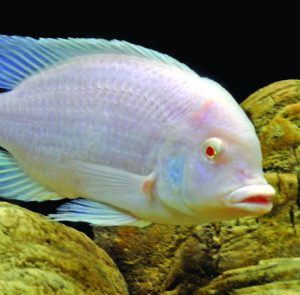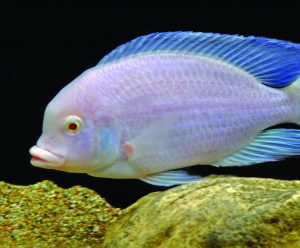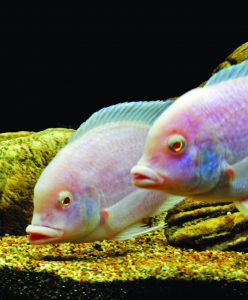Many will agree with me when I say that the Blue Dolphin Cichlid (Latin name: Cyrtocara moorii) would easily make anybody’s list of the top ten all-time favorite cichlids. The claim that the albino variety of this species is getting much attention, however, is no white lie.

The gorgeous cichlid from Lake Malawi is known for its majestic blue color, impressive size, and, based on African Cichlid standards, a well-mannered demeanor, all of which make this a favorite among cichlid keepers.
C. moorii was introduced to the Philippines in the 1970s. The first time I saw the species, I was still in the process of trying to convince myself that I had mustache and beard growing on my face. Four decades later, the hair — well, whatever is left of it — is turning gray, yet the C. moorii is still a favorite among Filipino cichlid keepers.
Blue Beginnings
This fish was first described by Belgian-British zoologist George Albert Boulenger in 1902. It was more popularly known as Haplochromis moorii but now belongs to the genus Cyrtocara. The genus name was derived from the Greek words kyrtos, which means bent, and kara, which means face, owing to the distinct curved face and hump on the forehead. This feature will remind you of the face of a Bottlenose Dolphin, hence its common name, Blue Dolphin Cichlid.

The species is endemic to Lake Malawi but is said to be widely distributed throughout the lake.
It was reported that exports of C. moorii mostly came from the Lumbaulo and Malombe regions. The Albino variant, however, was believed to have been selectively bred in captivity, and does not exist in Lake Malawi. It is believed that the Albino variant is exclusively an aquarium fish.
Whether albino or not, juveniles are ivory white in color all over. They lose some of this luster and turn pinkish-white, and may develop a light blue sheen across the body, a blue blotch on the operculum, and a shade of blue on the dorsal, anal, and caudal fins as they mature.
Old Favorite, New Look
C. moorii is a Malawi Cichlid that every true-blue fishkeeper grew up with. Puns aside, this fish is truly blue all over — just about one of the bluest fishes we have in the aquarium, in fact. But all that changed this year when I was reintroduced to a rare albino variant of the same fish I first saw 40 years ago.

Instead of being blue, this variant of the C. moorii is undeniably white. It is white with red eyes, just like any animal with true albinism.
Tips to Keep an Albino Blue Dolphin Cichlid Happy
To ensure that the albino C. moorii stays healthy and happy, here are a few things to remember.
- The aquarium must have a minimum capacity of 75 gallons.They are rather large cichlids that grow to about 8 to 10 inches, thus requiring an aquarium 75 gallons or bigger.
- The filter should have a capacity of 10 to 20 percent of the tank. The tank must be outfitted with an adequate filter. Provide a pump with a flow rate equal to at least two turnovers in an hour. A weekly forty-percent water change should keep your water quality in optimum conditions.
- Keep only a small school of C. moorii in a tank. They are quite social and are normally calmer with just a few of them in a tank. It is best to have just six of them in your tank because they are shoaling fish. They are generally more peaceful compared to other Malawi Cichlids, such as the mbunas that are more aggressive and territorial.
- A solo male makes a happy colony. Males are normally polygamous and a colony of one male with five or six females is a good ratio. Too many males will result in some aggression.
Ideal Habitat
Lake Malawi is one of the major Rift Valley Lakes of East Africa. The lake is known for its highly alkaline and highly mineralized water. Considering that it is quite a hardy fish, the Blue Dolphin Cichlid may be kept in water with a pH range of 7.0 to 9.0, general water hardness from 5 to 20 dGH, and temperatures between 22° to 30° C.

In the wild, it is observed as a sand sifter, digging up the sand for tiny morsel. Classified as a micro-predator, it is a carnivore that specializes in searching for tiny invertebrates at the bottom. In the aquarium, they will generally eat all kinds of live, fresh, and prepared commercial fish food. They do best with a high protein diet, so feed meaty foods such as blood worms and brine shrimp (either live or frozen), small pieces of cut up prawns, fish, and earthworms. To keep a good balance, supplement their meaty diet with a high quality prepared commercial fish food.
Male or Female, Can You Tell?
Determining the sex among Blue Dolphin Cichlids, albino or otherwise, is not an easy task as sexual dimorphism between the sexes is small. There are few physical differences between the genders, with no distinct feature to tell them apart. In other cichlid species, only the males develop a lump on the forehead called the nuchal hump or cranial bump. Among C. moorii, both genders have this.
In the standard blue variant of the C. moorii, females are often found to have black blotches on the flanks of the body and the males are mainly plain blue in color. However, in the albino variety, these black blotches in the females are non-existent. Both males and females are plain pinkish-white in color due to their albinism.
Size is another physical difference between the sexes. Males are generally larger than females, growing from 8 to 10 inches, while females max out at about 6.5 inches. While this may be an easy way to tell them apart, it may prove unreliable when you have C. moorii that come from different batches and ages. To be able to use this method, there should be about 20 juveniles grown to maturity and, after about two years, it is safe to assume that the two biggest fish are males. The smallest ones can be assumed to be females.
Another way to determine the sex is to observe the behavior of the fishes in the colony. Males seek out territories and guard them from others. They will dance and flare while protecting their territory, hoping to lure females. They have an aggressive stance, compared to the submissive females.
Finally, a sure way to tell a female from the male is when she holds eggs. In C. moorii, females lay the eggs and are fertilized by the male. Only the female holds the eggs, immediately picking them up and incubating them in her mouth. She then retreats to a quiet area in the territory of the male. Females holding eggs have distended oral cavities.
This appeared in Animal Scene magazine’s October 2018 issue.






